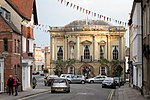The Wiltshire Museum, formerly known as Wiltshire Heritage Museum and Devizes Museum, is a museum, archive and library and art gallery established in 1874 in Devizes, Wiltshire, England. The museum was created and is run by the Wiltshire Archaeological and Natural History Society, a registered charity founded in 1853.
The society bought a former grammar school on Long Street, south of the town's market place, to house the museum. It later expanded into two Georgian houses on either side, and still occupies these premises today.The museum maintains a collection covering the archaeology, art, history and natural history of Wiltshire. The collection covers periods of history from as far back as the Palaeolithic and also has Neolithic, Bronze Age, Roman, Saxon, Mediaeval and more recent historical artefacts. Among the prehistoric collections are items from the Stonehenge and Avebury World Heritage Site. Several of the collections have been designated as being a significant part of England's cultural heritage.One of the most important collections at the museum is the finds from Bush Barrow, an early Bronze Age burial mound in the Stonehenge area. The barrow was excavated by William Cunnington in 1808 and produced the richest and most important finds from a Bronze Age grave in the Stonehenge Landscape to date. The finds were acquired by the museum in 1883 and were displayed there until 1922, when they were indefinitely loaned to the British Museum. After a controversial restoration of the largest piece that may not reflect its original finish, the pieces were returned to Devizes in 1985.The natural history collection includes remains of a plesiosaur called Bathyspondylus found at Swindon in 1774. Bathyspondylus swindoniensis was first described in 1982 from the museum's specimens.










